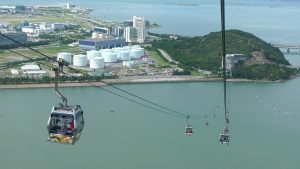I’ve shared with you in previous posts some traffic stories from Lagos and Nairobi (see Urban Transport, Transport Infrastructure Boosts Business). Could there be any more? Yes! The longer you sit there, the more stories you have to share – this is how bad traffic can get. Here’s another one: on my last day of a trip to Lagos, I was caught in a really bad traffic jam on my way to the airport. Despite having left my lodging with what I though was plenty of time, the jam was sooo bad that I started getting nervous. The driver noticed my stress. Trying to calm me down, he said: “Don’t worry, the Lord will blow the winds.” And… guess what! He did blow the winds! Just a few minutes later, at a juncture, the jam was dissolved. Maybe cable-cars are one solution to this huge problem.
I do believe in God and in his providence. However, I don’t think He will solve the problems that we don’t when we could. So, I’m happy to see that there are plans to improve transport infrastructure in many large cities across sub-Saharan Africa (SSA), including setting up cable-cars. This innovative transport system has many advantages:
- It has a low environmental impact
- It’s quick to build (estimated less than 2 years for a line),
- Its safety record is impeccable
- Both capital investment and operational costs are relatively low.
So far, there are few cable-car lines in the SSA region:
- In Cape Town, South Africa, the Table Mountain Aerial Cableway and in Hartbeesport, South Africa, the Hartbeespoort Aerial Cableway are already operational. These cable-cars were not built to solve city congestion issues but for touristic purposes.
- In Cross River State, Nigeria, the Obudu Mountain Resort. It was also built to give visitors a scenic view of the mountain.

Some cities are introducing them now to improve their transport network:
- In Mombasa, Kenya, the Likoni Channel project will connect Mombasa Island and the South Coast, 1300 meters, starting in March this year. Its capacity will be 11,000 passengers per hour in both directions. The trip will shorten to about only two minutes down from ten minutes that it takes now to cross it using the ferry service.
- In Lagos, Nigeria, the cable-car will be 12.85 km long and will connect Lagos Island with both the mainland and Victoria Island. The estimated capacity is 240,000 trips a day, and the expectation is that it will reduce average journey times by as much as 70 minutes.
Once again, this is an area where SSA has the potential to leapfrog: these investments will provide a clean and fast alternative method of transport. They will reduce the intense traffic jams that people suffer on a daily basis, and will contribute to overall efficiency: as of now, most executives hire drivers so that they can work done during the rides.
Any doubts about the African leapfrog potential?
Nadim Elayan, Research Assistant at IESE Business School, collaborated in this article.
________________________________________________________________________
RELATED ARTICLES


No doubt that the capacity of most African countries to attract investors, become compatitive and generate jobs locally goes through local governments’ capacity build infrastructure that are to adjust to the growing challenges the in the near future. Issues such population growth, mobility, cost, environment and so on are to be taken into consideration. The suggestion is also to look at connectivity accross the country, and cross-borders. Transportation represents a huge opportunity to generate jobs and growth for many African countries.
Good to see that some countries are looking into it.
Hi Sergio,
yes, connectivity across the country and cross-borders is critical for business. I talked about the role of transportation in intra-African trade in an earlier article. In case you’re interested, you may find it here: “Intra-African trade and transportation”